
What does Vietnam need to prepare to 'resolve' the CBAM?
Latest
 |
| The CBAM aims to levy a charge on imports based on the carbon emissions generated in the production of the products. (Photo: Collective Evolution) |
In an interview with The World & Vietnam Report, Dr Devmali Perera, Lecturer in Finance, The Business School, RMIT University Vietnam said that, by immediately implementing short-term solutions and implementing long-term strategies, Vietnam can solve the challenges of CBAM and work towards realizing the national commitment to achieve net zero emissions by 2050.
The European Union's (EU) Carbon Border Adjustment Mechanism (CBAM) is a carbon tax levied on imported goods. This is a strategy launched within the framework of a commitment to reduce carbon emissions worldwide and realize the goals set by the Paris Agreement on climate change. Can you give us a breakdown of challenges/issues that Vietnamese businesses will face when the EU executes the Carbon Border Adjustment Mechanism (CBAM)?
According to a World Bank report from 2022, the GHG emission levels of Vietnam have rapidly increased over the last 30 years along with the rapid economic growth of the country. The economic expansion, urbanization, and industrialization of Vietnam have been mainly driven by a coal-dependent energy supply that creates significant GHG emissions. Hence, the CBAM will definitely have a significant impact on Vietnamese exports to EU.
However, the CBAM will not uniformly impact all of Vietnam's exports to the EU. Its effects will predominantly be felt in four main export industries: iron and steel, aluminum, cement, and fertilizer. For Vietnamese businesses exporting to the EU, the implementation of the CBAM presents several challenges.
First, this tax will likely increase the costs associated with Vietnamese exports to the EU and hence reduce the profitability or income generated from those exports. The CBAM aims to levy a charge on imports based on the carbon emissions generated in the production of the products. This means that goods produced in countries like Vietnam without stringent carbon pricing policies will be subject to additional costs when entering the EU. Exporters will either have to absorb these costs, reducing their profit margins, or pass them on to consumers, potentially making their products less competitive in global trade.
In my opinion, the second burning challenge in Vietnam is the lack of awareness of the CBAM and its impact on the local businesses. In general, there is a noticeable gap in understanding and implementation of carbon pricing and carbon emissions reporting among Vietnamese businesses. This concept represents a relatively novel and evolving issue within Vietnam, highlighting an urgent need for increased education and integration of these environmental considerations into the business strategy.
Along with that, there's a need for widespread education and awareness among Vietnamese businesses about the CBAM in particular – its implications and how to mitigate its impact. This includes understanding international carbon trading mechanisms, emission reduction strategies, and leveraging any available exemptions or lower tariffs for greener products.
Third, in order to reduce the carbon tax burden and maintain market competitiveness in the long run, Vietnamese firms might need to invest in cleaner, greener technologies and production methods. This transition requires capital, research, and development efforts, which could be challenging for small and medium-sized enterprises in Vietnam.
Furthermore, to comply with CBAM, Vietnamese businesses need to accurately calculate the carbon footprint of their products. This requires a transparent and reliable system to track and report carbon emissions of a business, which may necessitate significant adjustments in current practices and infrastructure in the local context.
Finally, the lack of well-defined policies or strategic roadmap to help local businesses effectively navigate the CBAM presents another significant hurdle. The government has taken some initiatives including hosting a workshop in Hanoi to increase awareness of how Vietnam can mitigate the negative impacts of the CBAM and how this transition can be converted into an opportunity to achieve net zero goals. The workshop was conducted in collaboration with the Energy Transition Partnership (ETP) managed by the United Nations Office for Project Services. Such efforts aim to assess the CBAM's impact on Vietnam's export products and economy, providing vital data and policy recommendations for a roadmap and design of a carbon tax system in Vietnam.
The successful navigation of these challenges requires a coordinated effort between the government, businesses, and other stakeholders to ensure that Vietnamese exports remain competitive in the EU market while contributing to the global effort to combat climate change.
 |
| Dr Devmali Perera, Lecturer in Finance, The Business School, RMIT University Vietnam. (Photo: MN) |
What measures do you think Vietnam can implement to mitigate the impacts of CBAM in the short term?
In the short term, Vietnam as a country should focus on mainly two things. First, the government should actively engage in dialogue with the EU and other trading partners to negotiate for transitional arrangements, technical support, and capacity building. Collaborating with other affected countries to share experiences and strategies can also strengthen Vietnam's position in advocating for fair and equitable implementation of the CBAM. For instance, Africa is projected to be the most affected by the CBAM, facing significant impacts on its economy and exports to the EU in sectors like aluminum, iron and steel, fertilizer, and cement. In Asia, Thailand and India are also expected to experience substantial impacts facing GDP decreases due to the inclusion of carbon-intensive exports in the CBAM. Ongoing dialogue and cooperation will pave the way for the successful development of a strategic plan aimed at addressing this challenge over the long term.
Second, raising awareness among Vietnamese exporters about the CBAM and its implications is fundamental. The government, in collaboration with industry associations and international partners, should organize training programs and workshops to build capacity in carbon management and green production techniques. Simultaneously, the government can motivate local enterprises to reassess their supply chains and identify immediate actions to enhance energy efficiency in production. This involves embracing cutting-edge, energy-saving technologies and methods. By endorsing energy audits and providing financial rewards for implementing energy-efficient solutions, the government can accelerate the adoption process. This approach will equip local companies for robust carbon reporting and carbon trading mechanisms in the future, ensuring long-term compliance and sustainability.
What about in the long term? How can Vietnam build appropriate carbon tax policies that are suitable for the Vietnamese economy?
The most effective long-term strategy for Vietnam involves establishing a comprehensive carbon pricing mechanism and a robust carbon reporting system coupled with a strategic plan aiming to decarbonize the businesses in Vietnam. This approach will guide businesses towards adopting sustainable practices by aligning economic incentives with environmental sustainability goals.
Any country, including Vietnam, has the capability to create its own carbon market and levy a carbon tax on domestic businesses. In the event that these exporters are liable to a local carbon tax that is equal to the EU's CBAM tax, the EU has declared its readiness to recognize this and possibly deduct an equivalent amount. Hence, Vietnam can also introduce such a carbon tax on local businesses in this regard.
For example, India has recently introduced its Carbon Credit Trading Scheme (CCTS) to achieve their low carbon objectives. Effectively implementing CCTS will enable Indian businesses to prove their products are made using low-carbon and green technologies, potentially reducing CBAM charges and boosting green energy exports to the EU.
In order to achieve a greener economy, the Vietnamese government has implemented an environmental protection tax since 2010. To bring Vietnamese companies in line with global best practices, the Ministry of Science and Technology integrated the ISO 14067:2020 standard in 2020. This standard sets forth the fundamental requirements and recommendations for businesses to precisely calculate and disclose their carbon footprint. Despite the presence of these regulations, Vietnam's carbon market still remains underdeveloped. Hence, it is important to develop carbon tax policies suitable for the Vietnamese economy and to diligently enhance awareness among local businesses regarding these policies.
Vietnam’s rapid industrial growth during the last decade has led to a significant increase in GHG emissions. Given this scenario, it is important to conduct a detailed evaluation of the country's carbon footprint. According to the World Bank report from 2022, the energy sector accounted for about 65%, the highest percentage of GHG emissions, and the agriculture sector was responsible for about 19% of Vietnam's emissions as of 2020. Therefore, sector-specific tax rates would be more effective instead of a one-size-fits-all carbon tax. The highest emitters like the energy sector, particularly coal-dependent energy production, can be taxed at the highest level. Furthermore, a phased implementation of the carbon tax will allow businesses time to adjust and invest in cleaner technologies.
A more sustainable approach would be to encourage businesses to decarbonize their supply chains. Government can utilize the carbon tax revenue to fund renewable energy projects, technology upgrades, and support for research and development in sustainable practices. In addition, financial incentives such as tax rebates, subsidies for purchasing green technology, or grants for sustainability projects can be granted for businesses. By directly linking financial benefits with emission reduction efforts, businesses will be more motivated to invest in decarbonization.
In conclusion, the successful deployment of carbon tax policies and the decarbonization of supply chains center on the collective support and comprehension from a wide range of stakeholders, encompassing businesses, policymakers, and the general public. Countries such as the US, UK, and Japan are considering the adoption of carbon taxes in the near future. This move is likely to have a significant impact on export revenues, particularly for nations like Vietnam, which rely heavily on export-driven economic growth. Therefore, it is essential to implement short-term strategies to mitigate the impact of the CBAM on Vietnamese exports, while simultaneously working towards fulfilling the nation's commitment to achieving net-zero emissions by 2050.
Thank you very much, Dr Devmali Perera!
| CBAM is a carbon tax imposed on imported goods. This tax is designed to level the playing field between EU producers, who are subject to strict carbon emission standards, and producers from other countries that may not have such stringent measures on carbon emissions. Within the framework of the European Climate Law, the EU has set a bold commitment to cut its net greenhouse gas (GHG) emissions by a minimum of 55% by the year 2030. To achieve this ambitious goal, the EU has introduced the 'Fit for 55' legislative package, designed to ensure every sector of its economy is aligned with this target, facilitating a comprehensive approach to environmental sustainability across the board. The CBAM represents a strategy introduced as part of this agreement aimed at decreasing worldwide carbon emissions and achieving the objectives established by the Paris Agreement. |





















